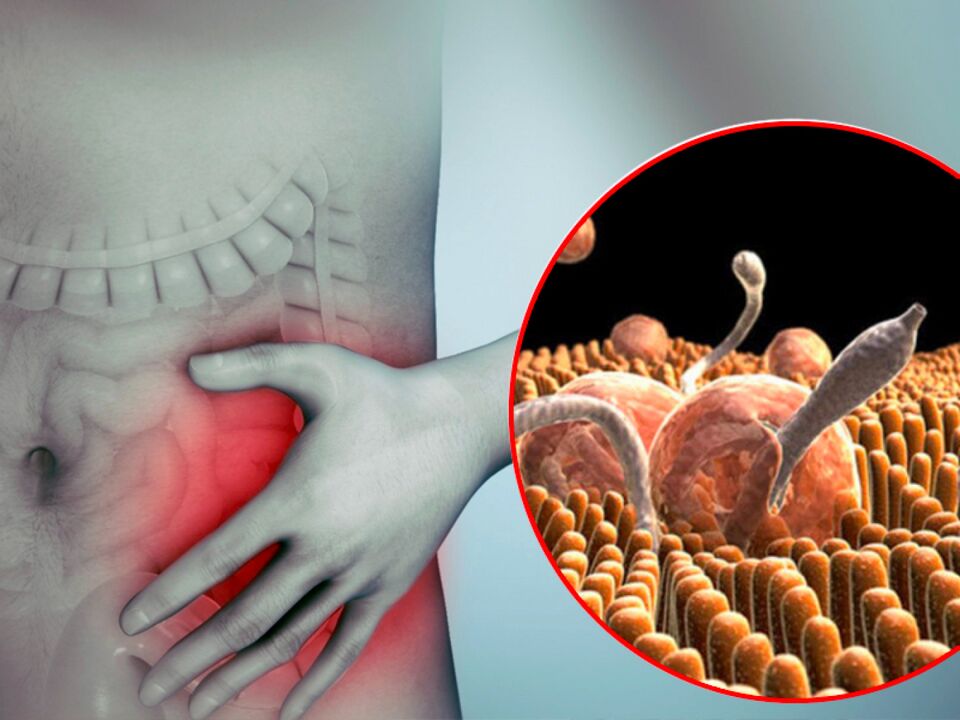
protozoan parasites
- Sarcopodia: uses pseudopods for locomotion. These include the amoeba (dysenteric liver abscess), amoeba (colitis), and Acanthamoeba (can cause a serious and often fatal infection of the brain and spinal cord called granulomatous encephalitis).
- Flagellates (sarcomastigotes): Use flagella for movement. These include giardiasis (diarrhoea), trypanosomiasis (sleeping sickness and Chagas disease), leishmaniasis (visceral, cutaneous and mucocutaneous leishmaniasis) and trichomoniasis (a sexualtransmitted infections (STI)).
- Apical Complex: The apical complex is used for movement. Includes Plasmodium (malaria), Toxoplasma gondii (zoonotic infection caused by the parasite Toxoplasma gondii, with a variety of clinical symptoms in humans).
- Ciliates: These ciliates move by cilia and include a large protozoan, Barania, which is the only ciliate known to infect humans (dysentery). Approximately 1% of the world's population is infected with cysticercosis.
worm
- Flukes: Fasciola hepatica – a liver fluke; Fasciola buschii – an intestinal fluke; Paragonimus westermani – a lung fluke; Schistosoma is a blood fluke.
- Cestodes: Diphyllobothrium Latum – broad tapeworm; Hymenolepis Nana – dwarf tapeworm; Taenia Saginata – cattle tapeworm; Taenia solium – pork tapeworm.
- Nematodes (roundworms) cause a variety of diseases in humans, which may be intestinal or may directly affect certain tissues. roundworms
- Lumbricoides - giant roundworms; pinworms - pinworms, etc.
ectoparasites
- Bed bugs are a common parasite called bed bugs.
- Dermatobia hominis are the larvae of the human gadfly.
- Sarcoptes scabiei is a mite that causes scabies.
Pathological causes
- Food and water are contaminated. Improperly treated or contaminated water sources may contain parasites such as Giardia lamblia and Cryptosporidium parvum, which can cause gastrointestinal infections. Eating undercooked or contaminated food, especially raw or undercooked meat and seafood, can lead to the spread of parasites such as Toxoplasma gondii and Trichinella spiralis.
- Poor hygiene and sanitation. Many parasitic infections, especially those caused by helminths (e. g. , roundworms, hookworms), are spread through contact with fecal-contaminated soil, food, or water.
- Vector transmission via insect vectors. Parasites such as Plasmodium (malaria), trypanosomes (Chagas disease, African sleeping sickness), and filarial worms (causing lymphatic filariasis) are transmitted through the bites of infected insects (mosquitoes, bed bugs, and midges).
- Animal-to-human transmission: Some parasites are hosts in animals, and humans can become infected through direct contact with an infected animal or its excrement. For example, Toxoplasma gondii can be spread through contact with cat feces.
- Imported infection. Individuals who travel to areas where certain parasites are endemic may be at risk of contracting infections not commonly seen in their home country.
- Transmission from person to person. Some parasites in the body, especially intestinal parasites such as pinworms (pinworms) and Giardia lamblia, can be spread through direct contact between people, usually in crowded or communal living conditions.
- Contaminated soil: Certain types of worms, including nematodes, can infect humans through contact with contaminated soil containing parasite eggs or larvae.
disease symptoms
- Abdominal pain, cramping, and discomfort.
- Nausea and vomiting.
- Diarrhea or constipation.
- Weight loss and malnutrition.
- Anemia occurs due to loss of blood and nutrients.
- There are visible insects in the feces.
- Perianal itching (Pinworm (pinworm) infection can cause perianal itching in children, especially at night).
- Respiratory symptoms: Some worms, such as roundworms, can migrate into the respiratory tract and cause symptoms such as coughing and wheezing.
- High temperature: In some cases, worm infection can cause a low-grade fever.
- Certain liver fluke or tapeworm infections can cause enlargement of the liver (hepatomegaly) or spleen (splenomegaly).
Diagnosis of disease
- To diagnose hydatid disease, serology and sometimes liver ultrasound are required.
- Metatesticular disease can be diagnosed by stool examination, serological testing, and sometimes DNA testing.
- Toxocariasis can be detected by a Toxocara antibody test, a parasite DNA test, and a general blood test that shows eosinophilia.
- Giardiasis is diagnosed by stool analysis and serological testing.
- To diagnose ascariasis, stool microscopy and a roundworm antibody test are used.
- Trichinellosis: Serological testing and DNA analysis of Trichinella spiralis.
treat
Disease prediction and prevention
- Wash your hands thoroughly with soap and water after using the toilet, before eating, and after touching pets or soil.
- Keep your nails short and clean to minimize the risk of parasite eggs or cysts developing under your nails.
- Cook meat, fish and poultry thoroughly to kill parasites. Wash fruits and vegetables thoroughly, especially those eaten raw.
- Drink purified or boiled safe drinking water, especially when traveling to areas with a high risk of waterborne parasites.
- Use insect repellent to prevent bites from mosquitoes, ticks, and other vectors that can transmit parasitic diseases.
- Make sure your pet receives regular veterinary check-ups and deworming medication.
- Dispose of pet waste properly to minimize the risk of pest infestation.


















